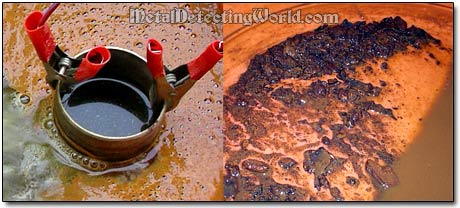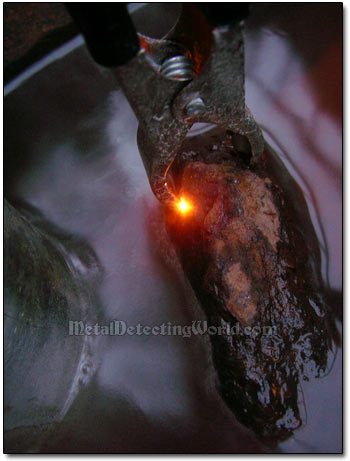Rust Removal by Electrolysis - A Detailed Illustrated Tutorial, page 41
10. Safety Precautions: Crud and Precipitated Rust Disposal, Prevent Overheating
8) Crud and Precipitated Rust Disposal
In commercial rust removal by electrolysis, waste disposal has to comply with environmental laws and regulations.
If you conduct your home electrolytic derusting, any waste produced during the process - mostly crud and precipitated rust, is exempt from hazardous waste disposal requirements.
But, of course, common sense applies when there is a risk of damaging the local environment.
When you conduct home electrolysis on a large scale, the only two cases of the harmful waste disposal might be the following:
1) Electrolytic solution, crud and precipitate are contaminated with compounds of toxic Hexavalent Chromium which is dissolved into electrolyte from the stainless steel anodes and then partially released in gaseous form as vapor.
2) Electrolytic solution, crud and precipitate are contaminated with trapped Chlorine which first evolves bubbling off the anode, then dissolves in the electrolyte, and, as the electrolyte gets saturated with the chlorine, bubbles out of the solution and rises up along with the oxygen in the mist directly above the bath during electrolysis. Table salt, after it dissolves into its component ions in the electrolytic soltution, is the only source of Chlorine.
The rest of the gross chemical "soup" in a container is relatively harmless, generally consisting of hydrated iron oxides, carbon dioxide, sodium carbonate, calcium carbonate (when sodium carbonate reacts with the calcium ions present in tap water), dissolved components of baking soda (or washing soda), and trapped oxygen and hydrogen gasses. There will also be some minor contaminants depending on how well the iron objects to be derususted have been cleaned of oils, paint, crusted gunk and tar resedue prior to the electrolysis. To sum it up, the chemical soup consists of nothing else besides what one puts in it.
Surfacial Crud (on the left) and Mix of Contaminants and Precipitated Rust (on the right)

The iron-rich dirty electrolytic solution along with crud and gunk can be carefully poured down the drain, as this mix is similar to what already goes into the municipal waste sewers through cast iron pipes. Any amount of the precipitated rust mixed with other minor contaminants can be collected into a plastic bag and then dumped into the garbage can. Of course, you can dump it down the drain if you want to see WHAT might happen to the pipes in your house! (not recommended)
If you have utilized a lot of stainless steel material during electrolysis, and your electrolytic solution has become heavily contaminated with hexavalent chromium, you will have to collect all the precipitates, take them outside, and spread them on a tarpolin under the sun. After the toxic precipitates get dehydrated, place them in a sealed plastic bag, and take it to a designated place at the minicipal landfill. If you have any questions, contact your state's environmental office.
9) Prevent Overheating of Power Supply
Although, most of the modern car battery chargers have cooling fans that prevent overheating, it is important to keep voltage and current below dangerous level to avoid any risk of overheating your power source and other components of the electrolytic setup. Also do not cover the car battery charger with a box or bucket. If tightly covered, the charger will overheat with a possibility of burning up as the cooling fan will be circulating hot air only.
If you are unsure of any of the safety aspects described above or unsure about your safety - STOP! Get help before you do something unwise. Use common sense, be smart about what you are doing, and stay safe so you can finish your iron artifact restoration project and enjoy it.

Make a Donation
Please help me stay afloat, afford more metal detecting trips with field-tests and experiments to create more informative articles, useful tutorials and helpful guides for detectorists, and maintain this website - the most informative hobby resource on the web! Since I do not have any steady income, any donation matters to me a lot! Thank you kindly!
Clicking on the donate button will take you to a donation page powered by Donorbox and dedicated to my website (MetalDetectingWorld.com). The donation page is PCI-compliant, secured by SSL/TLS, and has a simple form to fill out. Donorbox does not store any card or bank data. Credit card information is encrypted and tokenized by the Stripe payment processor.
This website would not exist without the advertisements we display and your kind donations. If you are unable to support us by viewing our advertisements, please consider making a Donation to ensure the future of this website. By helping me keep this website alive and growing, you will sure help many detectorists around the world as well!
ANNOUNCEMENT:
In January of 2020, I started a one-time fund-raising campaign in attempt to accumulate enough money to buy a simple but reliable 4x4 vehicle. My old 4x4 car (made in 1995) had faithfully served me for 10 years before it eventually went beyond repair last October. Without a 4WD, I will not be able to get to my hunt sites and test-plots hidden in the remote wooded areas inaccessible by a regular car.
Unlucky for me, those sites are the only locations available and suitable for my field-work which results in informative articles you can find on this website. For the past 10 years, my usual field-work has consisted of field-testing the latest metal detectors and accessories, experimenting with some of them, and devising new effective search methods that meet the requirements of the new metal detecting reality.
Before my car died, I managed to finish a couple of interesting detector-testing projects which will be covered in my upcoming articles. But other equally important projects that I was working on were not completed and had to be postponed until the Spring 2020. I hope that this fund-raising campaign will help me get a decent 4x4 by then so that I will be able to resume my work and to write more new articles, tutorials and guides based on data gathered through testing and experimentation.
If you find my website useful and would like it to provide more essential info for you and other detectorists worldwide, please consider chipping in $5, $20, $50 or whatever you can afford to keep MetalDetectingWorld.com growing in 2020. I promise you, it will be money well spent. Thank you.
DonateA Complete Guide to Coin Cleaning
Source: en.wikipedia.org
- Please help me promote this tutorial:
If you would like to follow me on Twitter, please press a button:
I have my profile page on
where you can share your thoughts on this tutorial, ask me a question, or place a friend request.I also have my profile pages on Pinterest, LinkedIn, Tumblr, Reddit and Delicious
and my "Metal Detecting World" page on Twitter, Pinterest and Tumblr
I no longer maintain my old Facebook page